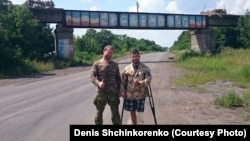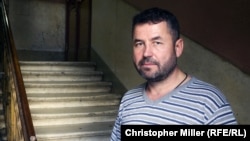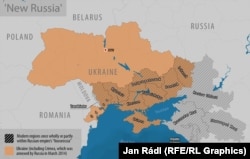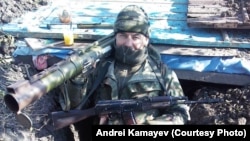MOSCOW/ST. PETERSBURG -- Russian volunteer Andrei Kamayev arrived in war-torn eastern Ukraine in late September 2014, bursting with patriotic bravado and convinced that he was following in the footsteps of his grandfather -- a Soviet intelligence officer in World War II -- by fighting against "fascists and Nazis."
Using terms propagated by the Kremlin to describe Ukrainian government forces fighting Russia-backed separatists, the 49-year-old Kamayev admits to other motives for joining up: he also wanted to help restore the "Russky Mir," or Russian World, and stave off the perceived encroachment of NATO.
But his dream of military glory came to a quick and devastating end on February 1, 2015. As Kamayev followed a convoy of tanks during an assault near the strategic town of Debaltseve -- then Ukrainian-controlled -- a mortar shell exploded beside him, shredding part of his left leg. He was evacuated to a nearby hospital, but without the proper medicine to treat him, gangrene set in and doctors were forced to amputate the rest of his leg up to his hip.
He was lucky to survive, unlike many fellow Russians who volunteered to fight in Ukraine. But back in his new home, St. Petersburg, Kamayev hobbles around the former imperial capital on crutches and struggles to get by.
For him and thousands of other unrecognized, so-called veterans of the Kremlin-fomented conflict in eastern Ukraine, there is little, if any, glory beyond the battlefields of a war that grinds into a fourth year, with no end in sight.
No Official Recognition
These Russian vets didn't return to a hero's welcome. Most bear permanent scars, both physically and mentally, and with no veterans benefits and few jobs available they struggle to make ends meet. Moreover, infighting among different groups of them over ideology, strategy, and legacy has kept them from uniting as a more influential voice.
They include the Union of Volunteers of Donbas, a group headed by Aleksandr Borodai, the former leader of the self-proclaimed "Donetsk People's Republic." The group is closely tied to the Kremlin through Vladislav Surkov, Russian President Vladimir Putin's point man on the conflict, and seen by some volunteers as being elitist. RFE/RL spoke with some members of the group in a village outside Kaluga, where they were participating in war games on July 30.
Another is the Public Movement of Novorossia, an organization headed by Igor "Strelkov" Girkin, a Russian who commanded separatist forces in the first months of the war but is viewed by many volunteers as a traitor for retreating and relinquishing territory in Ukraine to Kyiv. Girkin, who was eventually recalled to Moscow by the Kremlin, didn't respond to RFE/RL's request for an interview.
Kamayev does what he can to help by running Veterans of Novorossia, a St. Petersburg-based NGO whose name ("New Russia") draws on an imperial-era term denoting large parts of today's southern and eastern Ukraine. His deputy, 41-year-old Denis Shchinkorenko, fought in arguably the bloodiest action of the Ukrainian war -- the battle for Ilovaysk.
They assist Russian volunteers who fight or fought in eastern Ukraine, many of whom are frustrated and disappointed with the uncertainty of their future, Kamayev says.
RFE/RL's interviews with more than a dozen other fighters in Moscow, St. Petersburg, and Kaluga support that assessment, and illustrate how the thousands of Russians who fought in Ukraine find it difficult to readjust to daily life and now exist on the fringes of society.
They get no official state support of any kind. Kamayev lives on a measly state pension that he gets not for military service, but "for being an invalid -- like if I had been hit by a passing trolleybus." It's a sick irony, he suggests, that those who make it back from Ukraine in one piece have to struggle to get by.
The volunteers feel left out, perhaps because they were never really recognized in the first place.
While President Putin has not dismissed the possibility that some Russians might volunteer to fight in Ukraine, he has denied supplying them with arms and the Kremlin has officially refused to acknowledge their role.
Essentially, what the Kremlin gets is a large and powerful proxy army that allows it to maintain plausible deniability of official involvement in the Ukraine conflict. The volunteer soldiers, according to the fighters themselves, get next to nothing.
Fighting For The 'Russian World'
Kamayev puts the number of Russian fighters registered with Veterans of Novorossia at 3,000, but the total size and breakdown of the Russian volunteer force is unclear. Other groups did not provide figures. Estimates range from zero, if you go by the lack of official Kremlin acknowledgement, to tens of thousands, according to Kyiv.
Kremlin-backed forces fighting in Ukraine comprise 39,300 active fighters, including 36,400 "Russian proxies" -- a figure that includes volunteer fighters from Russia, Ukraine, other former Soviet republics, and elsewhere, the Ukrainian Defense Ministry's Main Directorate of Intelligence told RFE/RL on August 7.
The remaining 2,900, according to the directorate, are Russian regular servicemen, an allegation of involvement that has consistently been denied by the Kremlin despite a mountain of evidence to the contrary.
Most volunteers who spoke to RFE/RL are ordinary citizens who have varying degrees of military training, but are eager to take up arms for reasons that range from patriotism to adventurism. RFE/RL is not identifying all of them by name because some requested anonymity for fear of their families finding out what they are doing, prospective employers learning their history, or due to outstanding warrants in Russia, among other reasons.
Many cite the restoration of the Russky Mir -- an area dominated by ethnic Russians and Russian-speakers that encompasses most of the territory of the former Soviet Union -- as a big inspiration. Another common reason for joining the separatist fight is the 2014 revolution that ousted Moscow-friendly Ukrainian President Viktor Yanukovych. Many volunteers describe the country's post-Euromaidan government as "illegal” and “fascist" -- terms spread by the Kremlin and Russian state media to whip up emotions over a revolution they consider a "coup." Others specifically cite the May 2014 Odesa tragedy, in which rioting and a fire left 48 pro-Russian activists dead, as well as what they feel is unwelcome NATO encroachment.
"NATO is getting closer and closer to us, despite the promises given in the early 1990s that it wouldn't expand this far east," Kamayev says, repeating a claim often made by Russian officials that has been widely debunked. "We used to have the great and powerful Soviet Union and now Russia is surrounded all over."
Still others took inspiration from Moscow's operation to annex Ukraine's Crimean Peninsula, wishing to help along what they had hoped would be the subsequent annexation of eastern Ukraine's Donbas region, where the number of people killed in fighting between government forces and separatists has climbed to 10,000 since April 2014. Russia has taken strides to incorporate the self-proclaimed Donetsk and Luhansk "people's republics" economically, and even recognized the separatist regions' passports and school diplomas, but has thus far shown no interest in bringing them officially into the fold.
And then there are the adventure-seekers who are merely looking for a taste of a real-war experience. This camp includes Emil, a 37-year-old Russian photographer who spoke to RFE/RL in Moscow. He declined to give his last name and was light on details about his roots except to say that he studied cinematography and once worked as a fashion photographer. Emil says he got a taste for war while photographing the 2008 Russia-Georgia conflict in Abkhazia, one of two breakaway Georgian regions over which the war was fought. He went to Ukraine when hostilities there were at their peak in 2014 and 2015, trading his camera for a gun after a friend was shot and wounded. When the conflict slowed to a simmer, he says, he went to photograph and fight in Syria and has returned "many times."
'Shoot And Run'
Born and raised in a small town near Yekaterinburg, Kamayev was excited to leave his life behind to fight for the battlefields of Donbas. He spent his 7,000 rubles ($115) in savings on a camouflage military uniform he got from a surplus store before flying to the southwestern city of Rostov-on-Don and making his way to the Russian-Ukrainian border. From there, he crossed into Ukraine's eastern Donetsk region without much questioning by Russian border guards.
"When you get to the border, you don't say you're going to fight. You say you are going for business or humanitarian reasons...or for vacation or to visit family," Kamayev explains. "If your documents are in order, you're let through easily."
Like most, upon his arrival Kamayev was given a beat-up old Kalashnikov rifle and 10 bullets -- just enough to "shoot and run," he says -- and ordered to the front line with the separatists' 1st Slovyansk Battalion in Nikishyne. Dubbed by Ukrainian media at the time as "the gates of hell," Nikishyne, which sits just 15 kilometers south of Debaltseve, suffered horribly under five months of heavy shelling that destroyed more than 90 percent of the homes there and left it looking like a moonscape.
Kamayev understood the dangers he was facing. By the time he joined the fight the number of people killed had topped 3,000, Donetsk airport had been obliterated, Malaysia Airlines flight MH17 had been shot out of the sky, and the deadliest battle of the war -- Ilovaysk, with a body count from both sides well over 1,000 -- had been fought.
He was surprised by the "chaos" he encountered, but was happy to be there and fought undeterred from the trenches for months. For his efforts he says he received only a onetime payment of 15,000 rubles, about $250, for fighting in October 2014. (Other fighters said they received nothing, or amounts far less than that.) He recalls there being no proper command structure, and the way he describes the infantry's role it sounds like volunteers were merely used as artillery fodder. Their sole purpose, he explains, was to grind down their enemy, hold their ground at all costs, and, if possible, to gain some. His unit of 10 men fought in two-hour shifts, allowing them some time to rest.
"You learn to find happiness in the little things," he says of his time at the front. "You're happy that you survived, you're happy that you ate...and got some sleep."
But happiness was a passing feeling. Three out of the 10 men he fought alongside returned home in coffins, while another five, including him, suffered serious injuries. Only two came home physically unscathed. Kamayev and Shchinkorenko say those grim casualty figures are generally in line with the thousands of volunteers who fought in eastern Ukraine.
No Homecoming Parties
In contrast to the boisterous public celebrations for the annual Airborne Forces Day on August 2, the day after RFE/RL met Kamayev in St. Petersburg, there have been no homecoming ceremonies for the Russian volunteer fighters, no street banners heralding their sacrifices, and certainly no medals of valor.
The only physical symbols of their achievements adorn the inside of a dark basement tucked behind a gray building that sits along a canal in St. Petersburg. The Museum of Military Valor of Donbas, as it is called, is filled with war artifacts brought over by volunteer fighters. Bullet and artillery casings, collections of badges with the emblems of different fighting units, photographs of pro-Russian propagandists (including a British blogger and an American radio host), and memorials to notorious commanders cut down in battle or assassinated sit in glass cases and hang on the walls.
Donning a camouflage uniform with a patch showing a Kalashnikov rifle above the words "we'll teach you how to have a dialogue" on the right sleeve, a baby-faced 26-year-old who goes by the nom de guerre Academic -- a name given to him by his comrades for his ability to make sense of military maps -- shows RFE/RL a helmet he says is "special."
"This one has the brain material of a Ukrainian Nazi inside," chuckles Academic, using the Kremlin propaganda term for Kyiv's government troops.
Academic says the museum keeps an electronic database of fighters killed in the war. He did not allow RFE/RL to view the list, but says there are "more than 3,000" names of Russians included in it.
Flags from Syria, including a flag of the extremist group Islamic State supposedly taken by fighters who decamped there after fighting in eastern Ukraine, are also on display.
Stress And Unemployment
Shchinkorenko says most volunteers who come to the Veterans of Novorossia office complain of suffering from serious psychological issues and feelings of "being transformed."
"To some extent, we remain there, at war," Shchinkorenko says. "I am trying to understand whether a postwar syndrome is actually a syndrome or maybe a transformation of personality."
Kamayev recalls one fighter who committed suicide. "He lived alone after he came back," he says. "Apparently, he didn't tell anyone that he was in Donbas and had nobody to talk to about it."
Veterans of Novorossia -- which stays afloat on Kamayev's pension and income from a small business Shchinkorenko co-owns, according to the men -- at least provides a place where volunteers can meet and discuss employment opportunities.
But with Russia's economy still struggling and few options available to them, many admit they have been forced to take jobs in Russia's shadow economy after failing to acquire remunerative employment. Some say their only work option was to take mercenary work in other war zones, such as Syria.
On the day RFE/RL visited, Vitaly, a Russian who declines to give last name but says he fought as a volunteer for three years before returning home with a wife from Donetsk, drops in to discuss prospective work, among other things. He says many of the guys try to find employment in Moscow as construction workers, or try their luck in Kerch, the Black Sea town on the annexed Crimean Peninsula where Russia is building a bridge from the mainland.
Some of the most desperate ones go back to Ukraine.
'Symbol Drenched In Blood'
Kamayev says there are far fewer volunteers willing to go to Ukraine and fight these days. Public support and crowdfunding to aid a cause isn't what it was three years ago. Word has spread to prospective recruits that it is not worth the risk, and the guys who fought and came back are disappointed that they failed to achieve their goal of capturing Novorossia.
"Novorossia is a symbol drenched in the blood of our close friends," Shchinkorenko says.
That the war has entered a stalemate of sorts and the fighting has become less intense has actually turned off some of those looking for serious combat experience, although the death toll among soldiers and civilians in the first six months of 2017 was double that over the same period of 2016, according to figures from the Ukrainian military and the Organization for Security and Cooperation in Europe (OSCE).
Asked about official military support, Kamayev grows tense but suggests that, yes, that, too, has ebbed.
A New Fight
Veterans of Novorossia has its eyes on a bigger prize -- the NGO wants to persuade the government to grant Russians who fought in Ukraine state status. It's a long shot, but one that could shape the fighters' futures.
The effort has yet to really get off the ground, however. Kamayev admits that to push hard for such status now would be ill-advised, given that it would mean formal recognition by Moscow of having a hand in the war. "The less we will demand for ourselves, the more the state will probably respect us," he says.
Even without formal recognition, however, his deputy, Shchinkorenko, believes Russia's Donbas volunteers will eventually be seen as heroes.
"We are the good guys," he says, conceding an important fact. "It depends on who will be in power [when the war ends] and who will write the history books."

















